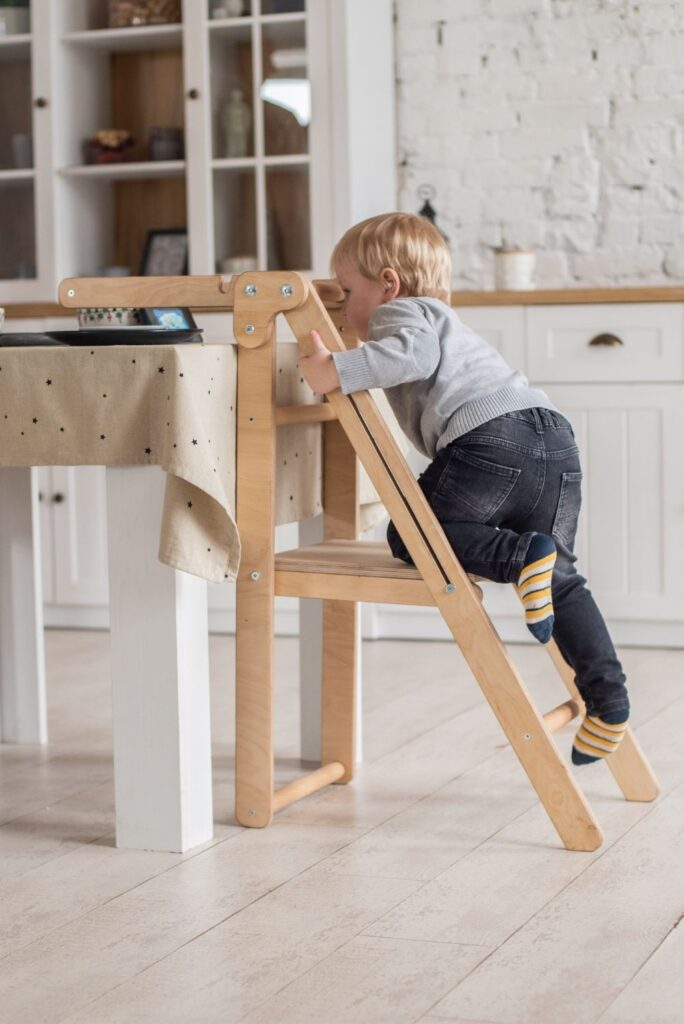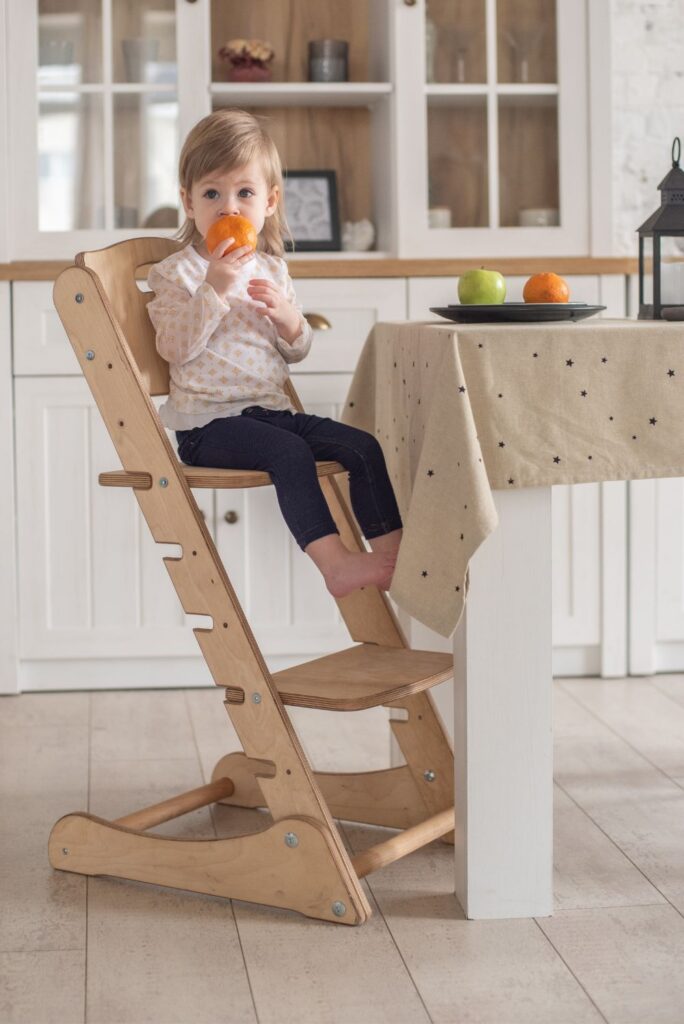The toddler years are a period of remarkable growth and development. Children are naturally curious, eager to explore their surroundings, and constantly refining their physical and cognitive skills. Waldorf Approach to education emphasizes a child-centered environment that fosters independence, exploration, and a love for learning. Montessori furniture is a key element in creating this nurturing space, providing toddlers with the tools to develop at their own pace.
Basic Сharacteristics of Montessori furniture
The best Montessori furniture for toddlers embodies the philosophy by adhering to a few basic principles:
Natural Materials
Montessori furniture stands out for its use of natural materials, with wood being a primary choice. This deliberate selection not only adds warmth and visual appeal to the learning environment but also provides children with an opportunity to connect with the natural world. By interacting with wooden furniture, children can develop an appreciation for the beauty of raw materials and gain a deeper understanding of sustainability and environmental stewardship. Additionally, using natural materials aligns with the Montessori philosophy of creating environments that reflect the beauty and simplicity of nature, fostering a sense of harmony and tranquility conducive to learning and exploration.
Simple and Functional Design
Montessori furniture avoids clutter and unnecessary embellishments. The focus is on clean lines, functionality, and ease of use. This allows children to focus on the activity at hand without distractions.
Child-Sized Proportions
Montessori furniture stands apart from traditional adult-sized furniture by its deliberate design with child-sized proportions in mind. Unlike standard pieces that cater to grown-ups, Montessori furniture is meticulously scaled down to suit the needs of toddlers.

This intentional adjustment enables children to effortlessly reach for objects, manipulate materials, and engage with their surroundings autonomously. By providing furniture that aligns with their physical dimensions, Montessori environments empower young learners to explore and interact with their environment independently, fostering a sense of confidence and capability from an early age.
Open-Ended Play
Montessori furniture is renowned for its versatility, allowing children to engage in imaginative and open-ended play. For instance, a simple low shelf can transform into various interactive settings, serving as a bookshelf to fuel literary adventures, a dollhouse for creative storytelling, or even a stage for dramatic performances. This multi-functional approach to furniture not only maximizes space but also stimulates children’s creativity and problem-solving skills as they explore different roles and scenarios. By embracing open-ended play, Montessori furniture encourages children to take the lead in their play experiences, fostering independence, self-expression, and a deeper connection to their surroundings.
Safety and Security
When it comes to creating a nurturing environment for young children, safety is paramount. Montessori furniture stands out for its commitment to safety and security, boasting features designed with little ones in mind.
- Rounded Edges: Montessori furniture is crafted with rounded edges to minimize the risk of bumps, bruises, and other injuries during play. By eliminating sharp corners and edges, these pieces provide a safe environment for children to explore and move freely without the risk of accidental harm.
- Sturdy Construction: Built to withstand the rigors of active play, Montessori furniture is constructed with sturdy materials that can withstand the weight and movement of young children. From climbing towers to tables and chairs, these pieces are designed to provide stability and support, ensuring a secure foundation for exploration and learning.
- Non-Toxic Finishes: Montessori furniture is finished with non-toxic paints and stains, ensuring that children are not exposed to harmful chemicals or substances during play. This commitment to safety extends to every aspect of the furniture, from the materials used to the finishes applied, providing parents with peace of mind knowing that their child’s health and well-being are prioritized.

By prioritizing safety features such as rounded edges, sturdy construction, and non-toxic finishes, Montessori furniture creates a safe and secure environment for young children to explore, learn, and grow.
Key Components of a Montessori Toddler Room
A Montessori toddler room is a carefully curated space that caters to a child’s natural developmental needs. Here are some essential furniture pieces to consider:
- Floor Bed: A floor bed, positioned directly on the floor, allows toddlers the freedom to climb in and out of bed safely. This fosters independence and a sense of control over their sleep environment.
- Low Shelves: Open shelving units at toddler height allow children to easily access and explore toys, books, and learning materials. This promotes self-directed learning and organization skills.
- Mirrors: Large, full-length mirrors placed at toddler eye level are fascinating for young children. They help develop self-awareness, spatial reasoning, and body coordination.
- Activity Tables and Chairs: A sturdy table and chairs set sized for toddlers provides a dedicated space for creative activities like drawing, painting, or manipulating objects.
- Climbing Structures: Montessori climbing structures, such as Pikler triangles or climbing arches, encourage gross motor skill development, balance, and coordination in a safe and controlled environment.
- Storage Solutions: Toddler-sized storage solutions like baskets or low cabinets allow children to put away their toys and learn organizational skills.
Beyond Furniture: Creating a Montessori-Inspired Environment
While furniture plays a crucial role, creating a truly Montessori-inspired environment goes beyond just the physical space. Here are some additional considerations:

- Natural Light and Ventilation: Ensure the room receives ample natural light and proper ventilation to create a healthy and stimulating atmosphere.
- Open Floor Space: Leave ample open floor space for movement and activities like crawling, climbing, and pretend play.
- Limited Stimuli: Avoid overcrowding the space with too many toys or distractions. Rotate toys regularly to maintain a sense of novelty and encourage exploration.
- Adult Role: The adult’s role in a Montessori environment is that of a facilitator and observer. Provide guidance and support when needed, but allow children to explore and learn at their own pace.
Empowering Growth: The Conclusion on Montessori Furniture
Integrating Montessori furniture and principles into your toddler’s environment goes beyond mere decoration—it’s about creating a nurturing space that cultivates their innate curiosity, fosters independence, and supports holistic development. By embracing these principles, you provide your child with opportunities for exploration, self-discovery, and a lifelong love for learning. Remember, the goal is to create an environment where your child can thrive, grow, and flourish into confident, capable individuals ready to take on the world.
Jessica has a flair for writing engaging blogs and articles. She enjoys reading and learning new things which enables her to write different topics and fields with ease. She also strives to break down complex concepts and make them easy for anybody to comprehend.





